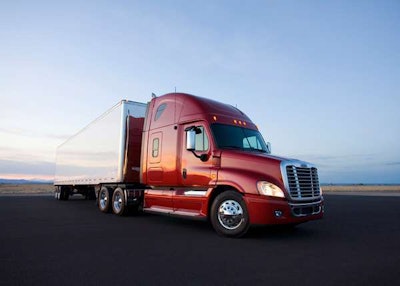 Freightliner Cascadia
Freightliner CascadiaAt a press conference Tuesday in Cabo San Lucas, Mexico, representatives from Daimler Trucks North America assessed marketshare data from late 2013, as well as initial 2014 results, to paint a picture of the company’s health and standing as the new year gets underway.
Retiring senior vice president, sales and marketing, Mark Lampert began the meeting by noting the historical trends that lead to Freightliner to its current marketshare leadership position are the result of long-term strategic decisions dating back to the 1980s coming to fruition.
Lampert says those efforts are evident in the company’s overall marketshare uptick of 4.2 percent in 2013. The final tally for Class 6 through 8 units sold last year was 339,000 trucks, with Lampert saying DTNA sold 37.9 percent of those trucks.
David Hames, general manager, marketing and strategy for DTNA, says he would like to see marketshare numbers hit the 40 percent threshold in 2014. Optimism aside, Hames says DTNA is “very comfortable” as it moves into the new year.
This confidence is bolstered, Hames noted, by extremely strong orders in January of this year.
“In that month, DTNA took the highest number of truck orders in than we have since 2006,” he says. “So we are off to a very strong start in the new year.”
The numbers cited by Lampert and Hames hold true in the company’s vocational market segments as well. Hames noted that DTNA finished 2013 with 31 percent vocational marketshare.
“For Freightliner, ‘vocational’ is defined by what we refer to as the ‘6 Super Segments,'” he explains. “They include specialized haul, utility, food and beverage, government, refuse and construction. And all indications are that our penetration in those segments is growing.”
Hames also talked at length on DTNA’s view that “vehicle integration” is that key to its future growth, as opposed to “vertical integration.”
“To my mind, ‘vertical integration’ suggests a focus on what’s good for the manufacturer,” he said. “And ‘vehicle integration’ focuses on what is in the customer’s best interest. And that is the philosophy that will drive our new product development moving forward.”
Hames says this approach is bearing fruit as well, noting that Detroit’s DD15 Diesel engine finished 2013 installed in 51 percent of all new Cascadia’s. Moreover, 69 percent of all new Cascadias sold this year have been spec’d with the DD15.










